A. Off-street parking shall be provided in conformity with the off-street parking requirements as set forth in the Schedule of Off-Street Parking Regulations, which is hereby adopted and set forth below.
B. Parking Schedule
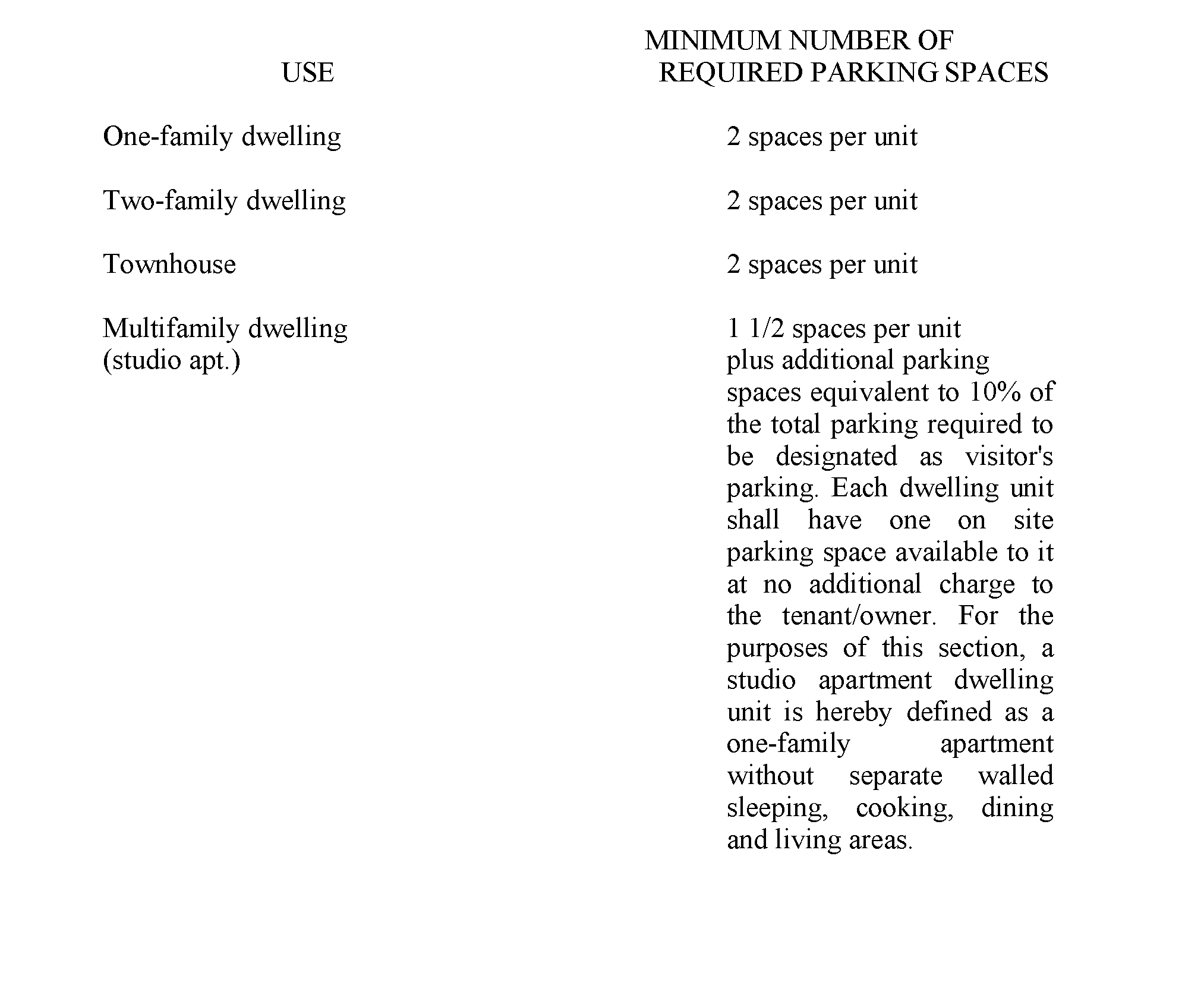
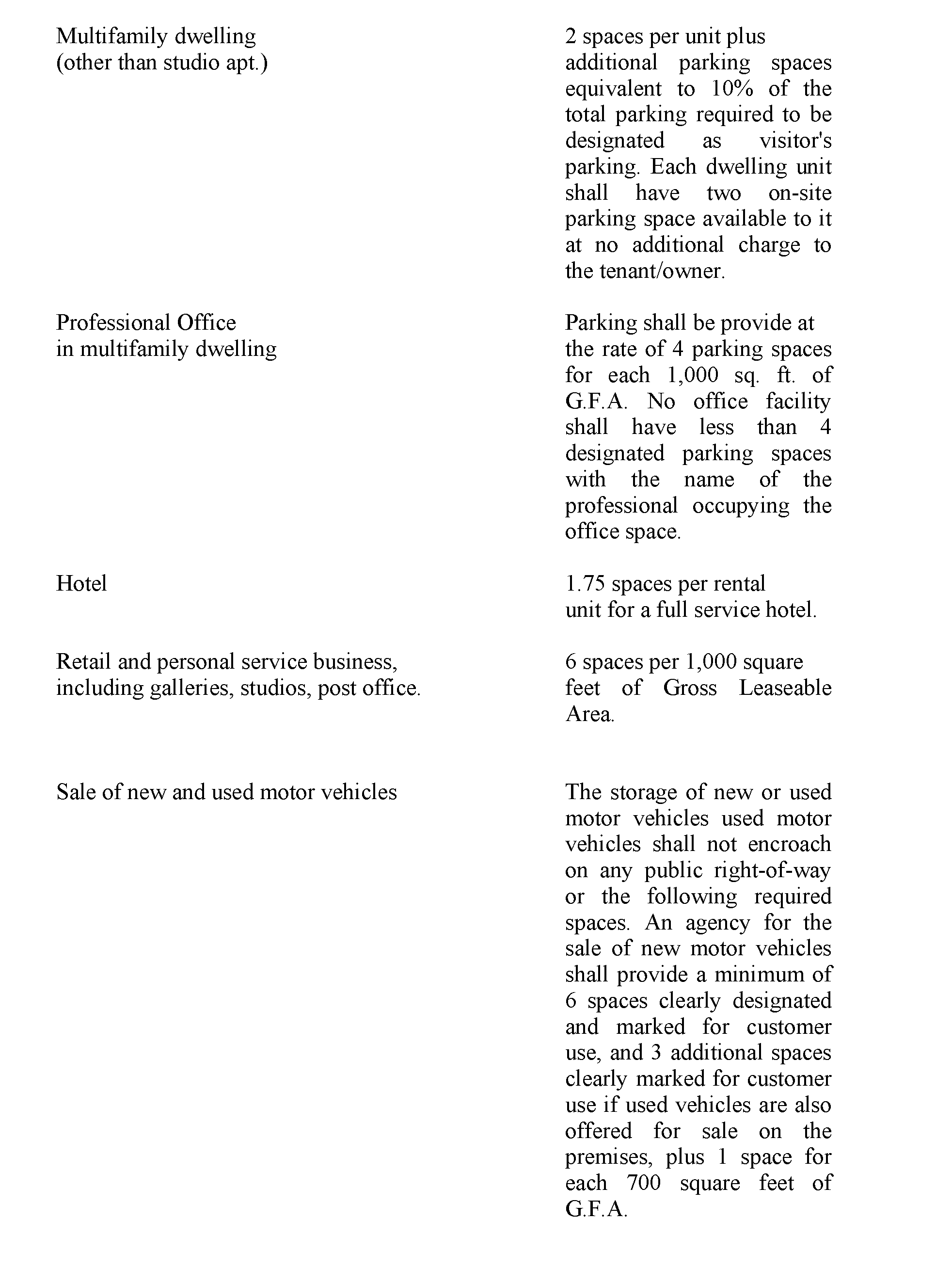
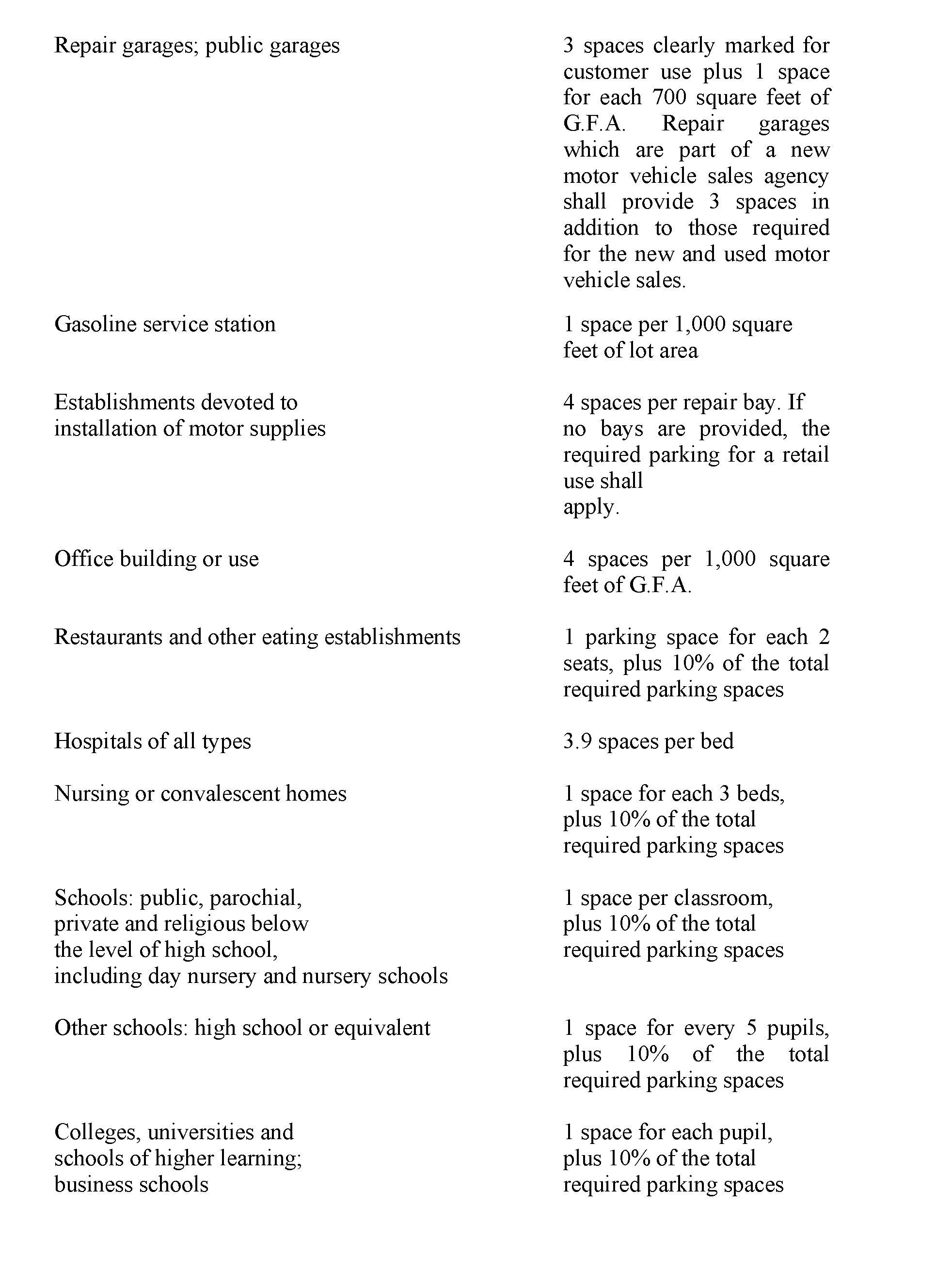
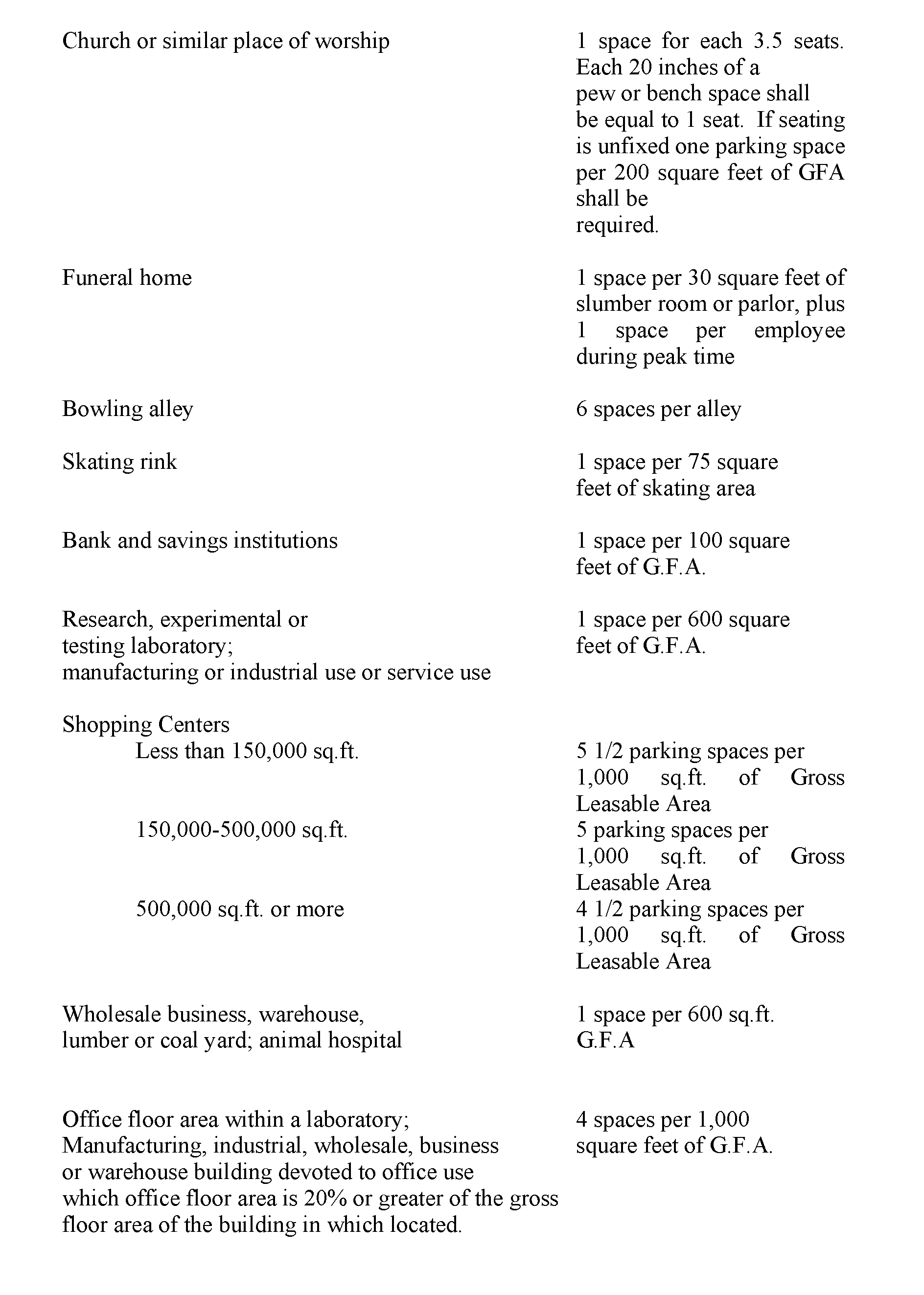
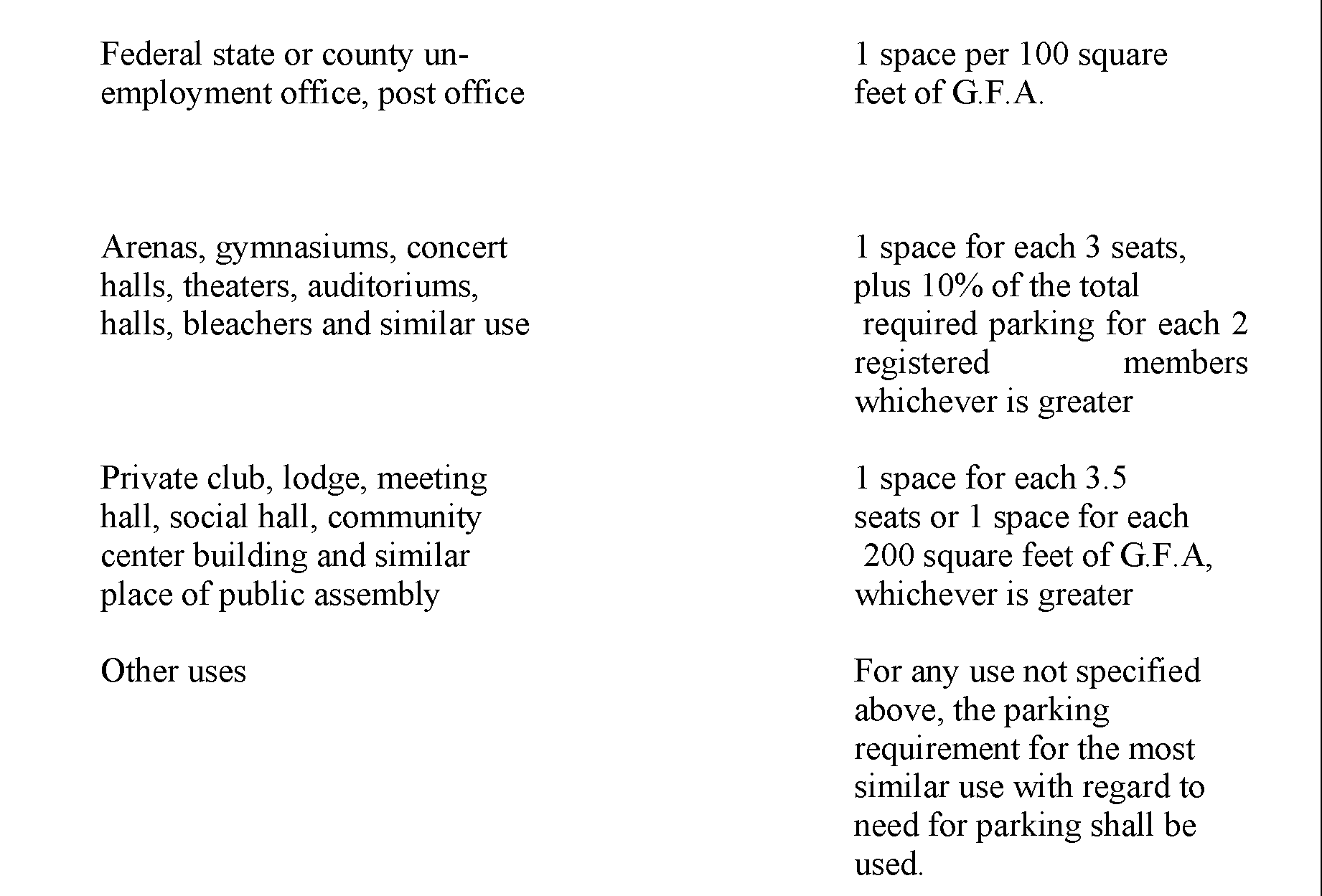
NOTE 1: In case of a combination of uses, the total requirements for the sum of the various uses shall be required. Whenever the formula for parking spaces required results in a fraction of a space exceeding forty-nine hundredths (0.49), a full space shall be required.
NOTE 2: G.F.A. denotes "Gross Floor Area", defined as the total interior floor area of all floors determined by measuring the inside dimension of the outside walls of the structure.
NOTE 3: In any off-street parking area containing twenty (20) or more parking spaces, up to thirty percent (30%) of the parking stalls may be designated for compact cars. Parking stall dimensions for compact cars shall be at least seven and five-tenths (7.5) feet in width and at least fifteen and zero tenths (15.0) feet in length. Such spaces for compact cars shall be clearly identified by signing or stall surface painting.
C. Handicapped Parking Schedule (as per the Americans with Disabilities Act)
If parking spaces are provided for self-parking by employees or visitors, or both, then accessible spaces shall be provided in each such parking area in conformance with the table below.
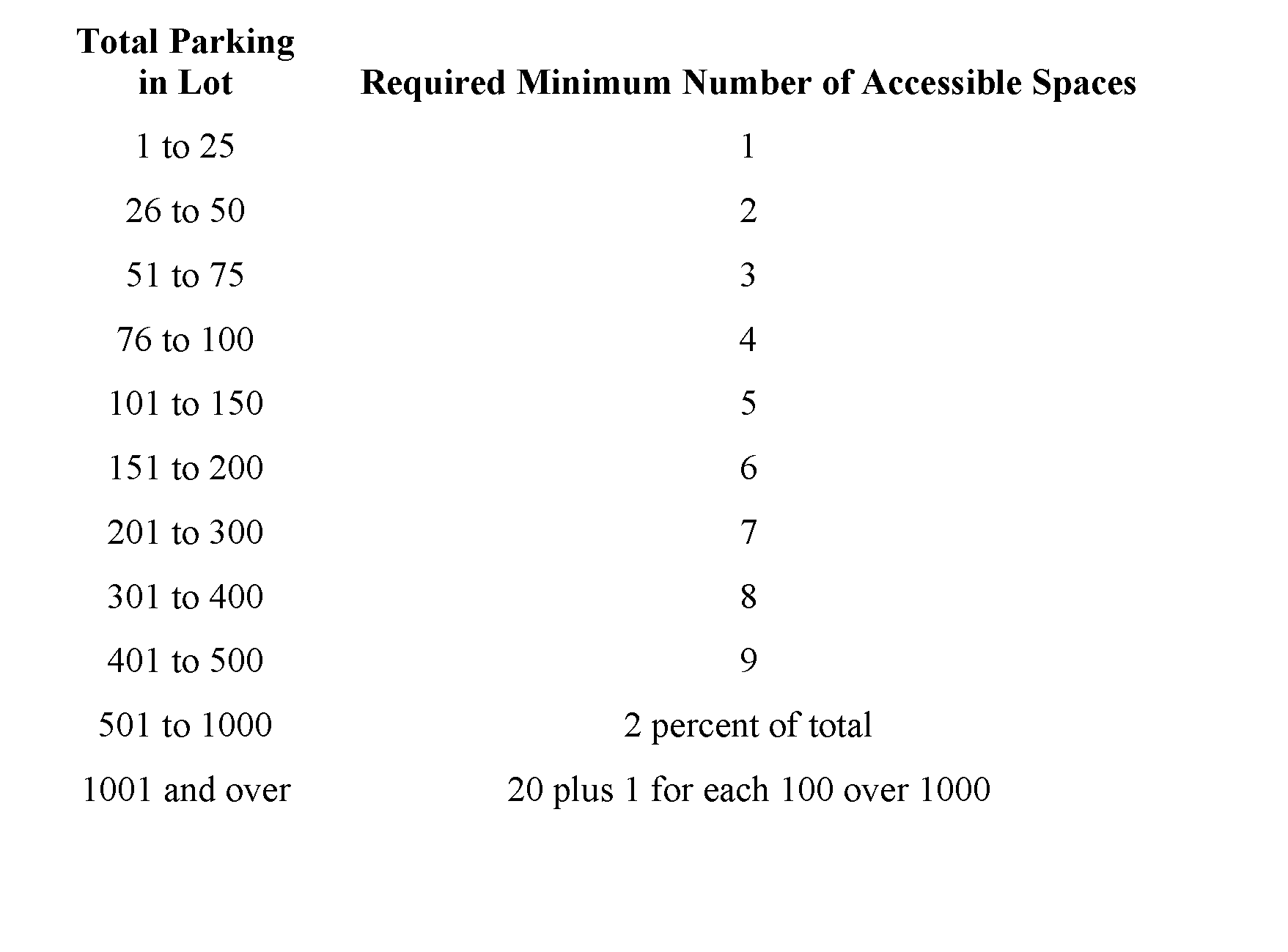
In addition to the provisions of the Schedule of Off-Street Parking Regulations contained in Section 175-10.1 of this Ordinance, there shall be applicable the special district regulations as set forth below.
A. Except for one- and two-family structures, all parking areas and driveways shall be paved with bituminous concrete, concrete or other approved permanent hard-surfaced material, and all parking spaces shall be lined and designated on said pavement.
B. Except for one and two-family structures, all parking areas and driveways must have a six (6) inch solid concrete or Belgian block curb to separate the parking area and/or driveway from the required front, side and rear yard when these parking areas are located within six (6) feet of the yard.
C. Except for driveways servicing one and two-family structures, the minimum width of any driveway along which parking is not permitted, used to service a parking area, shall be ten (10) feet and the maximum width shall be twelve (12) feet when used for one-way traffic. When used for two-way traffic, the minimum width shall be eighteen (18) feet and the maximum width shall be twenty-two (22) feet with no parking permitted.
D. Parking Stall and Driveway Requirements
(1) Driveway widths for other than one and two-family structures shall be the sizes indicated in the table below, depending upon their location and traffic flow.
(2) The parking layout tabulated below shall be for one-way traffic only and for parking on one (1) side of said driveway. A driveway for the above-mentioned parking requirement shall be provided with an exit and entrance to either another driveway, right-of-way or public thoroughfare. If said driveway does not comply with the above, a cul-de-sac shall be installed with a minimum radius of thirty-five (35) feet at its blind end. When said driveway serves two-way traffic, the minimum width of the driveway shall be twenty-two (22) feet, except for angle parking between seventy-six degrees (76) and ninety degrees (90) for standard sized spaces which shall be a minimum width of twenty-five (25) feet.
(3) For parking stalls and aisles, there shall be provided a minimum stall width of nine (9) feet and a minimum stall depth of eighteen (18) feet. Compact car spaces, where permitted, shall provide a minimum stall width of seven and five-tenths (7.5) feet and a minimum stall depth of fifteen (15) feet.
(a) The following minimum aisles widths shall be used:
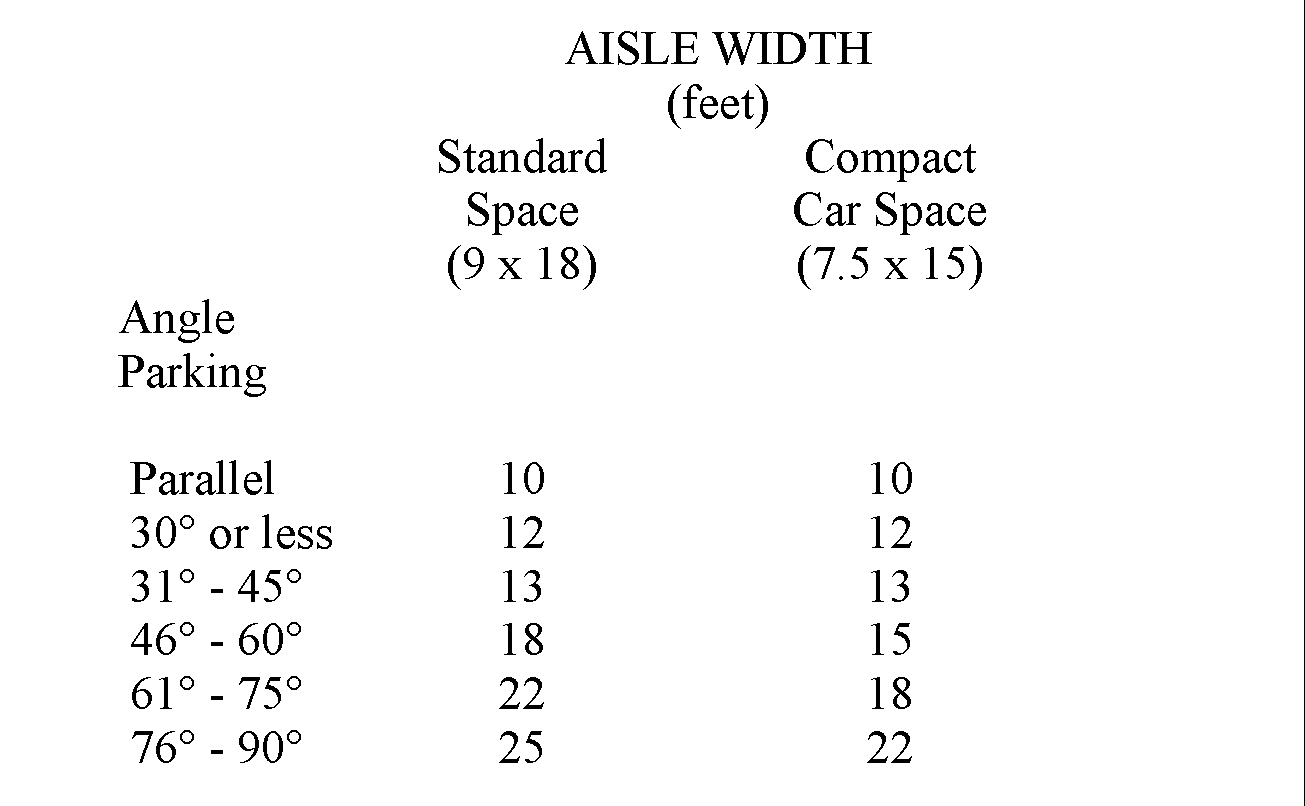
(b) Aisle providing access to both standard sized spaces and compact car spaces shall be of a width as required for standard sized spaces when the above requires a greater aisle width for such standard sized spaces than for such compact car spaces.
E. All parking areas required by this ordinance, when located in residential districts, except for one and two-family structures, shall be screened along the side or sides abutting a public street with either a solid fence or wall. Said fence or wall shall be a minimum of five (5) feet in height. Landscaping when required as per Article IX shall be provided. Semisolid walls shall be permitted with the approval of the Construction Official.
F. All parking areas required by this Ordinance, when located in residential districts, except for one-and two-family structures in all districts, shall be required to be sufficiently lighted so as to ensure safety to both pedestrians and motorists. Such lighting shall be in accordance with the following
(1) Nonattendant parking areas shall have a minimum of one-foot-candle-power lighting throughout the entire parking area.
(2) Attendant parking areas shall have a minimum two-foot candles lighting throughout the entire parking area.
(3) The lighting in parking areas shall be installed and arranged so as to throw no glare toward windows of dwellings on adjoining residential property.
G. No person shall store, garage or park, or permit the garaging, storing or parking of, any commercial vehicle upon any of the properties or premises or private roads within the boundaries of Residence Districts R-50, R 100, R-2, R-2A, R-2B, R-3, R-3A and R-3B provided, however that no more than one (1) commercial vehicle of not more than one (1) ton of rated load capacity per premises may be garaged within Residence Districts, R-50, R-100, R-2, R-2A, R-2B, R-3, R-3A, and R-3B provided if the said commercial vehicle or truck is stored within an enclosed private garage that is accessory to the main building in such residential districts. Nothing herein shall prohibit the parking of a commercial vehicle or truck for such reasonable times as may be required for pickup or delivery service to or from the occupants of premises within the said districts. Owners, lessees, occupants and other persons responsible for or knowingly permitting violations of this subsection on private property or roads shall be guilty of such violations, as well as the owner or user of any vehicle parking or garaged in violation of this subsection. Notice of violations of this subsection shall be given to the violator by the Police Department or the Department of Community Affairs; the posting of signs shall not be necessary in the enforcement hereof.
H. All parking spaces shall be laid out so as to have direct access from a driveway or aisle, and no double-parking shall be permitted except on driveways accessory to one and two-family dwellings.
I. Except for one and two-family structures, no off-street parking shall be permitted in the front, side or rear yards nor between the front setback line and the street right-of-way line of any multifamily dwelling in an R District, B-1, or B-2 District or of any office building in an R District. Driveways are permitted in the required front yard; however, no driveways, turn-arounds, traffic aisles or other paved areas are permitted in the required side or rear yards. Driveway aprons from an approved parking area to a public right-of-way or approved parking area on an adjacent lot are permitted in the required side and rear yards. No garage or parking area for a multifamily dwelling in an R District shall be designated so as of permit backup areas or turning areas to serve garages or parking stalls, which backup areas or turning areas are located in a required front, side or rear yard abutting any public street.
J. All off-street parking areas shall provide space to permit a vehicle to turn around on the site so as to avoid a backing maneuver within the street. Backing within the street shall only be permitted for driveways and parking associated with one and two-family residences.
K. Off-street loading and unloading shall be provided in such amount and manner that all loading and unloading operations will be conducted entirely within the boundaries of the lot concerned, and no vehicle shall use public streets, sidewalks or rights-of-way for loading or unloading operations, other than ingress and egress to the lot.
A. General Application
All industrial, business, office, multiple-family residential and health service uses, are subject to the following performance standards and procedures. Other uses, existing or proposed, which the Construction Code Official or Zoning Officer has reasonable grounds to believe violate these performance standards shall be subject to the provisions of this Ordinance as well.
B. Compliance With Performance Standards
(1) Prior to Construction and Operation.
Any application for a building permit for a use which shall be subject to performance standards shall be accompanied by a sworn statement by the owner of the subject property that said use will be operated in accordance with the performance standards set forth herein.
(2) Continued Compliance.
Continued compliance with performance standards is required and enforcement of continued compliance with these performance standards shall be enforced by the Construction Code Official and Zoning Officer
C. Nuisance Elements
The location where determinations are to be made for the enforcement of performance standards shall be made at or outside property lines of the use creating such element for noise, odor, vibration, glare, dust, smoke, air pollution or water pollution.
A. Vibration.
No vibration shall be permitted which is detectable without instruments at points of measurement specified in Section 175-10.3.
B. Glare.
No direct or sky-reflected glare shall be visible, whether from floodlights or from high-temperature processes, so as to be visible at the points of measurement specified in Section 175-10.3.
C. Smoke.
(1) The emission standards of this chapter or as promulgated by the New Jersey Department of Environmental Protection, whichever is more restrictive, shall pertain.
(2) No emission shall be permitted, from any chimney or otherwise, of visible gray smoke of a shade equal to or darker than No. 2 on the Power's Micro-Ringelmann Chart, published by McGraw-Hill Publishing Company, Inc. copyright 1954, being a direct facsimile reduction of a standard Ringelmann Chart as issued by the United States Bureau of Mines.
(3) The provisions of this subsection shall not apply to
(a) Smoke emitted during the cleaning of a fire box or the building of a new fire, the shade or appearance of which is not darker than No. 3 of the Power's Micro-Ringlemann Chart for a period or periods aggregating no more than three (3) minutes in any fifteen (15) consecutive minutes.
(b) Smoke resulting from any fire ignited solely for the purpose of training or research in fire prevention or protection.
(c) Smoke from locomotives the shade or appearance of which is equal to but not darker than No. 3 of the Power's Micro-Ringelmann Chart for a period or periods aggregating no more than thirty (30) seconds in any three (3) consecutive minutes, or smoke of said density for a period aggregating no more than four (4) minutes in any fifteen (15) consecutive minutes when building a new fire.
(d) Household fireplaces.
D. Odors.
No emission of odorous gases or other odorous matter in such quantity as to be readily detectable shall be permitted.
E. Dust.
Solid particles shall not be emitted in concentrations exceeding standards established by the New Jersey Department of Environmental Protection.
F. Flyash.
No emission of any fly ash shall be permitted to be discharged from any stack or chimney into the open air in excess of the quantity set forth in regulations promulgated by the New Jersey Department of Environmental Protection.
G. Noise.
No public address system shall be permitted except where such system shall not be audible at any property line.
At the points of measurement specified in Section 175-10.3. the maximum sound pressure level radiated in each standard octave band by any use or facility, other than transportation facilities or temporary construction work shall not exceed the values for octave bands lying within the several frequency limits given in the following table, after applying the corrections shown therein. The sound pressure level shall be measured with a sound level meter and associated octave band analyzer conforming to standards prescribed by the American Standards Association. American Standard Sound Level Meters for Measurements of Noise and Other Sounds, Z. 24.3-1944, American Standard Specifications for an Octave-Band Filter Set for the Analysis of Noise and Sounds, Z.24-10-1953, or latest approved revision thereof, American Standards Association, Inc., New York, New York, shall be used.
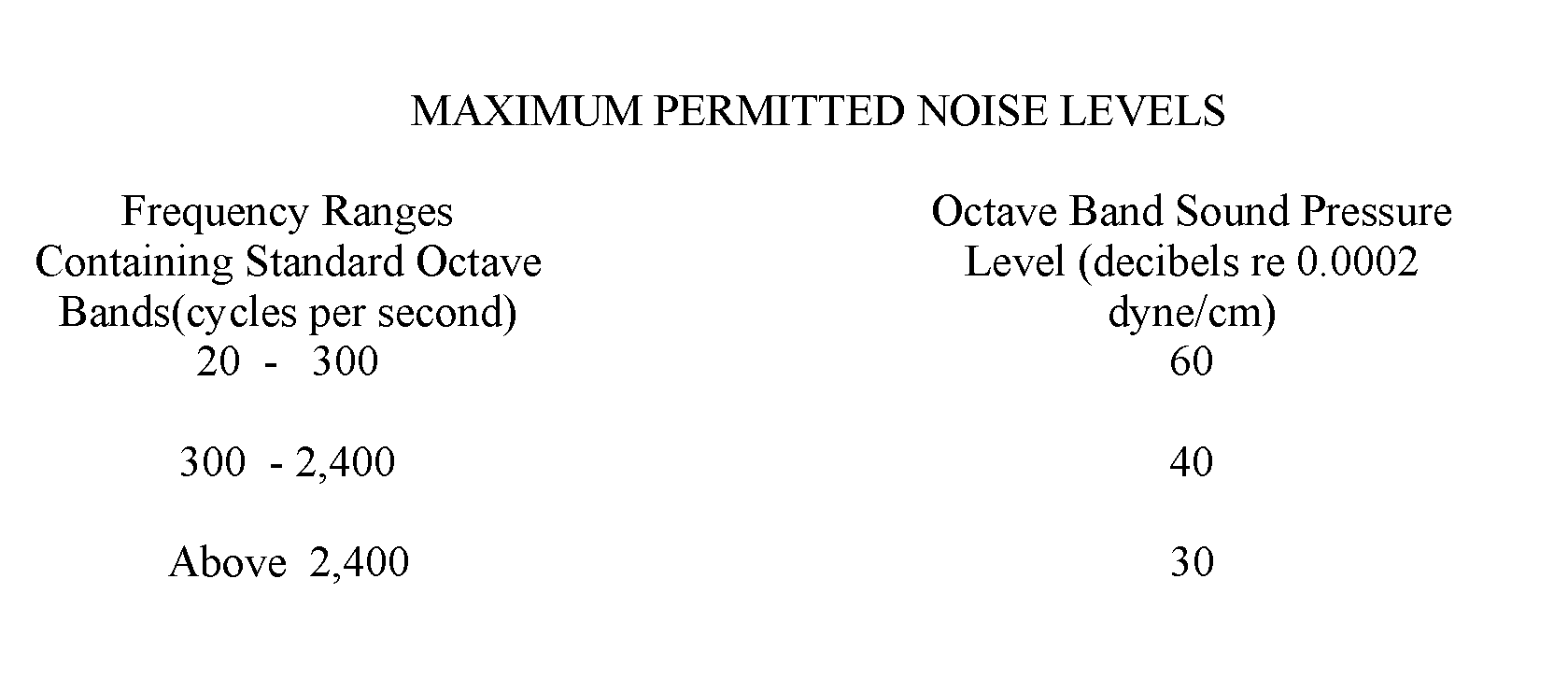
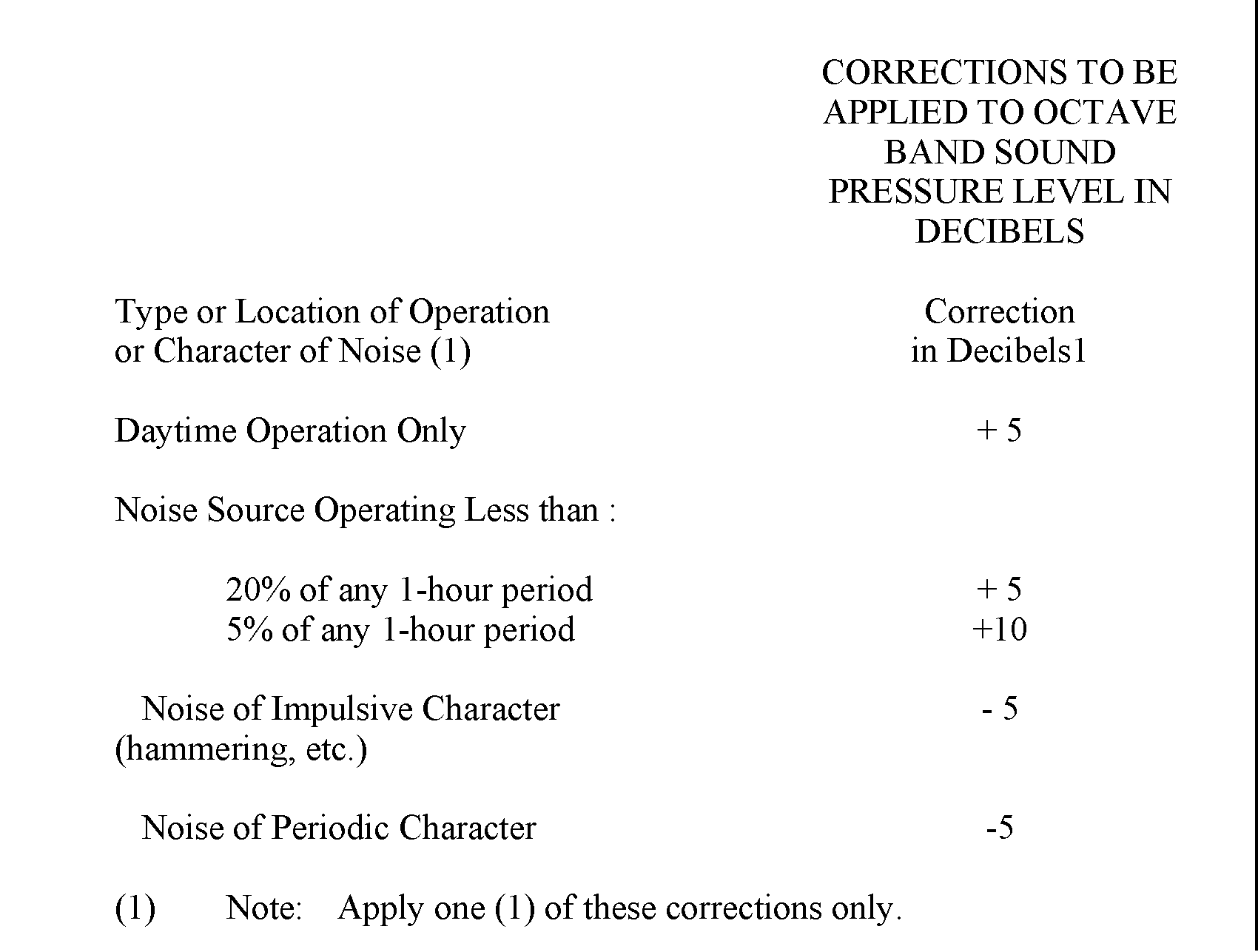
H. Radioactivity or Electrical Disturbance.
No activities shall be permitted which emit dangerous radioactivity or electrical disturbances adversely affecting the operation of any equipment. All applicable federal and state regulations shall be complied with.
I. Fire and Explosion Hazards.
All activities involving and all storage of flammable and explosive materials shall be provided with adequate safety devices against the hazard of fire and explosion and adequate fire-fighting and fire suppression equipment and devices standard in this industry. Burning of waste materials in open fires is prohibited. The relevant provisions of state and local laws and regulations shall also apply.
In the judgment of the Planning Board, in accordance with the spirit and intent of this Ordinance, the following design criteria shall be adhered to in each and every case, except where otherwise provided.
A. Traffic access: that all proposed site traffic accessways are adequate but not excessive in number; adequate in grade, width, alignment and visibility; and not located too near street corners, entrances to schools or places of public assembly; and other similar considerations.
B. Circulation and parking: that interior circulation is adequate and that all required parking spaces are provided and are easily accessible. All off-street parking and loading areas shall be surfaced with a durable and dust-free surface. All areas shall be properly marked so as to provide for the orderly and safe loading, parking and storage of self-propelled vehicles.
C. Lighting.
All exterior lighting devices shall be arranged so as to reflect the light away from adjoining premises. No rotating or flashing signs or lights shall be permitted.
D. Drainage, water supply and sewage disposal facilities.
All development shall be provided with adequate water supply, sewage disposal and drainage facilities in accordance with the City requirements.
E. Disposal of usable open space.
Usable open space shall be so arranged as to ensure the health and safety and to promote the general welfare.
F. Arrangement of buildings.
Adequate provision shall be made for light, air, access and privacy in the arrangement of buildings.
G. Landscaping.
Landscaping, where required, shall be provided in order to enhance and protect the natural and scenic qualities of the land. Where adjacent land use dictates, screening and buffer areas shall be required.
H. Wetlands.
Wetland areas and wetland transitional areas also known as wetland buffers shall be preserved and protected in accordance with law. Wetlands and wetland buffers shall not be considered usable open space.